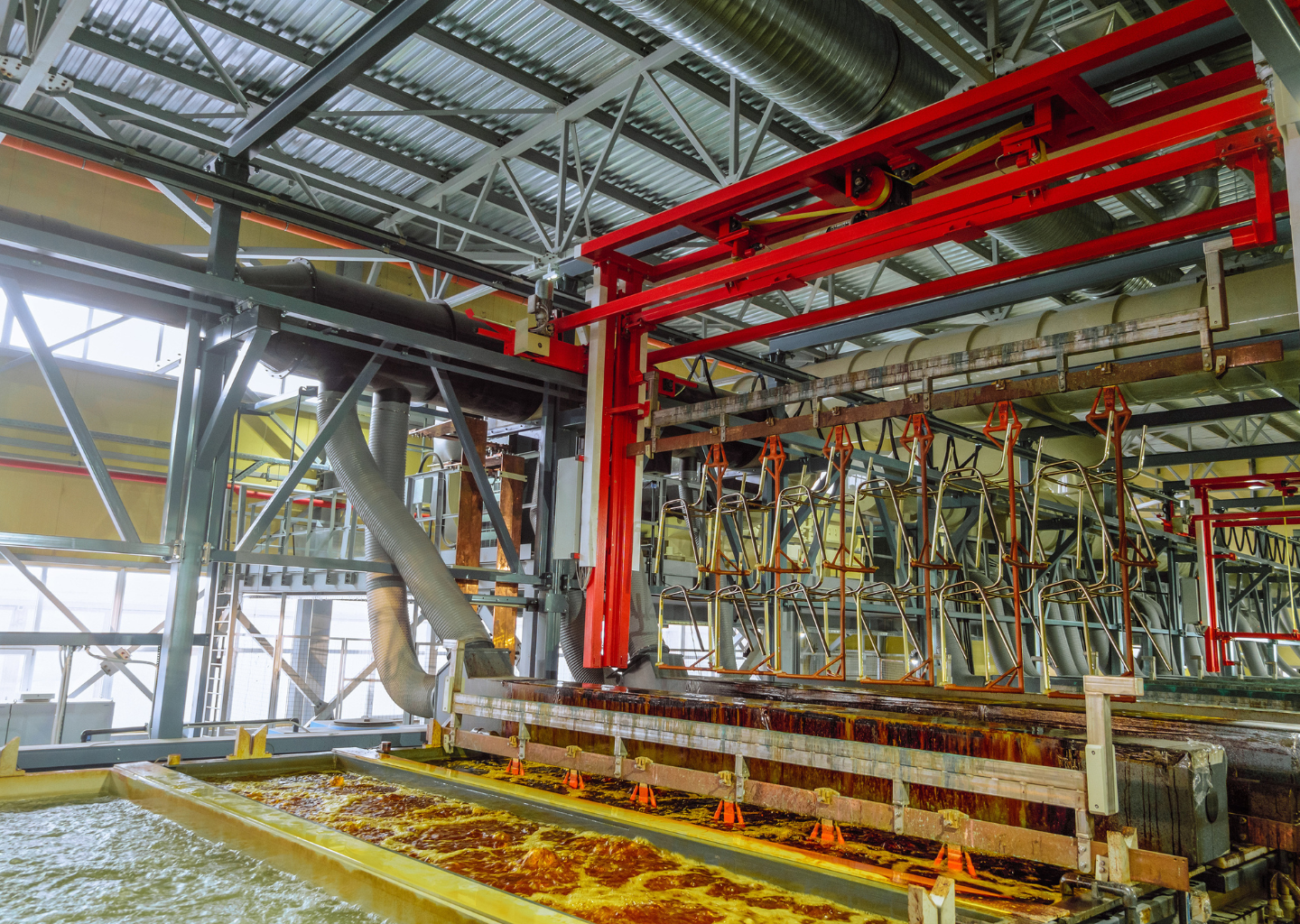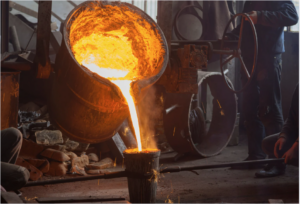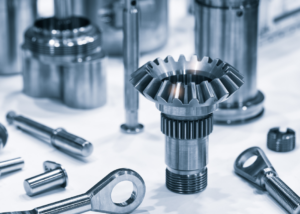
Metal products are all around us. Some have a beautiful shine, while others have a subdued black color that gives them a sense of weight. The technology that achieves these looks and further extends the life of products isplating (usu. in printing)It is.
Plating process is a technology to coat metal and non-metal surfaces with a thin metal film.Enhance DecorativeNot only,Various functions such as corrosion resistance, abrasion resistance, and electrical conductivity are added.You can do so. Specifically,Black dye treatmentis a method for blackening steel parts and improving corrosion resistance,zinc platingis a technology that coats steel materials with zinc to make them rust-resistant.
This article provides a comprehensive overview of the basics of plating processing, including types, effects, and specific examples of plating processes, as well as characteristics of black-dyeing treatment and zinc plating. If you are interested in the plating process, please read to the end.
Table of Contents
What is Plating? Creating added value through surface treatment
Plating is a surface treatment technique in which a thin film of another metal is coated on the surface of a metallic or non-metallic material. This thin film is a material'sornamentationIn addition to enhancing theCorrosion resistance, abrasion resistance, electrical conductivity, solderabilityVarious functions can be added, such as
There are various plating processes, including electroplating, electroless plating, hot-dip plating, and vacuum plating. Each method has its own characteristics, and it is important to select the best method for your purpose.
Types and Effects of Plating Finish
There are various types of plating processes. Each of them has a different metal to be coated, a different method, and a different added function. Typical types of plating processes and their effects are introduced below.
electroplating
Electroplating is a method that uses electricity to deposit metal ions on the surface of a material.Plating layer of uniform thicknesscan be formed,Applicable to parts with complex shapesIt is.
The main types of electroplating are as follows
- nickel plating: Improved corrosion resistance, wear resistance, and decorative properties, mainly used for mechanical parts and electronic equipment.
- chrome plating: Improved corrosion resistance, wear resistance, hardness, and decorative properties, especially used in automotive parts and decorative items.
- plate: Improved corrosion resistance and electrical conductivity, suitable for electronic devices and jewelry.
- silver-plating: Improved conductivity and decorative properties, used in electronic devices and decorative items.
- Copper plating: Improves electrical conductivity and solderability and is mainly used for electronic components and wiring.

electroless plating
Electroless plating is a method that uses a chemical reaction to deposit metal without the use of electricity. This method alsoUniform plating layer is obtained.The variousApplicable to shaped partsIt is.
The main types of electroless plating are as follows
- Nickel electroless plating:It improves corrosion and wear resistance and is particularly suitable for mechanical parts and coating applications.
- Gold electroless plating:It enhances corrosion resistance and electrical conductivity and is widely used in electronic devices and decorative items.
- Silver electroless plating:It improves conductivity and decorative properties and is especially used in electronic devices and decorative items.
- Copper electroless plating:Provides high conductivity and improved solderability. Used in electronic components and wiring.
hot-dip galvanizing
Hot-dip plating is a method of plating by immersing the material in melted metal.Thick plating layercan be formed,High corrosion resistancecan be granted.
- zinc plating: To increase corrosion resistance, molten zinc is melted and coded on the surface of steel materials. Mainly used in construction and automotive parts.
- Aluminum platingLightweight: Used for parts that require light weight and corrosion resistance, especially for aircraft and vehicle parts.
- Tin plating:Used in food packaging and beverage cans to prevent corrosion.
- Copper plating:Widely used in electronic components and wiring to enhance conductivity.
Vacuum plating
Vacuum plating is a method in which metal is evaporated in a vacuum and adhered to the material surface.Thin and uniform plating layercan be formed,Highly decorativeis a feature of this product.
- Aluminum Vapor Deposition: Evaporates aluminum to form a lightweight, corrosion-resistant thin film. Used in packaging and electronics.
- Sputtering:Skips atoms from the material used to form a uniform thin film. Used in the manufacture of semiconductors and displays.
- CVD (chemical vapor deposition):It produces a solid thin film by gas reaction and is suitable for cutting tools and wear-resistant parts.
zinc plating
Galvanizing improves corrosion resistance by plating zinc on steel and other surfaces to protect steel from corrosion. It is used for building materials and automotive parts to improve durability.
The following typical types of zinc plating are available
- Electro-galvanization: Thin plating layer, suitable for precision parts. Mainly used for small parts and electronic devices.
- Hot dip galvanizing:Steel is immersed in molten zinc to form a thick plating layer that provides excellent corrosion resistance. It is utilized in outdoor facilities such as large structures and building materials.

Black dye treatment
The black-dyeing process blackens the surface of steel parts,Improve corrosion resistanceThis is a process for There are various types of black oxidation treatments, including oxidation at high temperatures and the use of chemicals. The black oxidation treatment can be used to improve theIncrease rust-preventing effectNot only,Reduce light reflectionBecause of its effectiveness, it is also used for camera lenses.
Example of plating process
Plating is utilized for a wide variety of products. Some of them are introduced below.
Automotive Parts
For automotive parts,Corrosion resistance, abrasion resistance, decorative propertiesVarious functions are required, such as the following. Plating is widely used in the automotive industry because it can meet these requirements.
For example, automobile bumpers are often chrome-plated to provide both outstanding luster and corrosion resistance.

electronic parts (components)
For electronic components,Conductivity and solderabilityare required. Gold and silver plating are superior in these characteristics and have become indispensable technologies for the manufacture of electronic components.
For example, printed circuit boards are often plated with gold to achieve high conductivity and corrosion resistance.
Building Materials
For building materials,Corrosion resistance and durabilityare required. Because of its superiority in these characteristics, galvanizing is used in a variety of building materials, including roofing and exterior wall materials.
For example, zinc plating is used for large structures such as bridges and steel towers to provide long-term corrosion resistance.
medical equipment
For medical devices,Corrosion resistance, safety, biocompatibilityand other high-level characteristics are required. Special plating processes can meet these requirements and are used in the manufacture of medical devices.
For example, artificial joints and implants are sometimes plated with a biocompatible titanium alloy to minimize their impact on the human body.
The Future of Plating: Expectations for Further Evolution
Plating processes are constantly evolving. In recent years, R&D has been actively conducted to develop technologies to reduce environmental impact and to add new functions.
Conventional plating processes involve the use of hazardous chemicals. However, in recent years, with the tightening of environmental regulations,Plating processing technology with low environmental impactdevelopment is underway.
For example, hexavalent chromium-free plating processes and plating processes using water-soluble paints have been put to practical use.
Furthermore, the plating process does not merely coat a thin film of metal,Add new featuresIt is also becoming possible to add a new type of plating to the surface. Specifically, plating processes with antibacterial, antifouling, and water repellency properties have been developed.
Summary
Plating is an important technology that not only improves the durability and corrosion resistance of metal products, but also adds decorative and functional properties. There are various types of plating processes, such as black-dyeing treatment and zinc plating, each with different characteristics. We hope this article will help you to better understand the plating process.
We invite you to start your parts manufacturing with "Taiga" - Taiga is a highly secure and state-of-the-art technology that allows us to manufacture parts according to your needs. Please feel free to contact us first. Let's create new value for your parts together!
For more information about Taiga, click here.
 0120-987-742
0120-987-742


